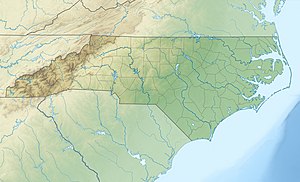| Pocosin Lakes National Wildlife Refuge | |
|---|---|
IUCN category IV (habitat/species management area) | |
 Looking down on part of Pocosin Lakes National Wildlife Refuge. | |
| Location | Hyde, Tyrrell, Washington counties, North Carolina, United States |
| Nearest city | Creswell, North Carolina |
| Coordinates | 35°45′03″N 76°30′37″W / 35.75097°N 76.510162°W |
| Area | 110,106 acres (445.58 km2) |
| Established | 1963 |
| Governing body | U.S. Fish and Wildlife Service |
| Website | Pocosin Lakes National Wildlife Refuge |
The Pocosin Lakes National Wildlife Refuge is located in North Carolina's Inner Banks on the Albemarle-Pamlico Peninsula in Hyde, Tyrrell, and Washington Counties, North Carolina. Its headquarters is located in Columbia.
Pocosin Lakes NWR was established in 1990. Originally, the 12,000-acre (49 km2) southwestern portion of the refuge, now known as the Pungo Unit, was established in 1963 as the Pungo National Wildlife Refuge, but was merged in 1990 with Pocosin Lakes. The National Wildlife Refuge is 110,106 acres (446 km2), and approximately 90,000 acres (364 km2) were donated. The refuge is named for the pocosin peat wetlands that make up the majority of the protected habitat.
This refuge is home to indigenous animals such as the black bear, alligator, two species of fox, bobcat, raccoon, coyote, opossum, beaver, river otter, mink, and red wolf. It was the site chosen for the reintroduction of the endangered red wolf in 1987.[1] It is located along the Atlantic Flyway and is home to more than 200 species of birds. The Pungo Lake unit is a notable overwintering site for Tundra swans, snow geese, and many species of ducks, with about 100,000 waterfowl in residence between November and January.[2][3]
- ^ "Wildlife & Habitat - Pocosin Lakes - U.S. Fish and Wildlife Service". www.fws.gov. Retrieved 2020-02-20.
- ^ "Pocosin Lakes NWR: The Hidden Gem of the Inner Banks". N.C. Wildlife Resources Commission. Retrieved 2020-02-20.
- ^ "Pungo - Pocosin Lakes". Audubon. 2016-09-12. Retrieved 2020-02-20.


